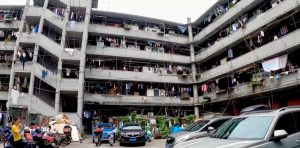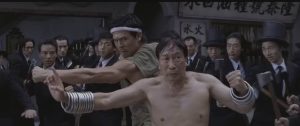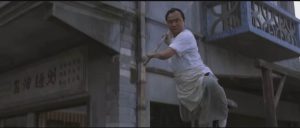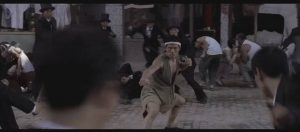KUNG FU HUSTLE, DIR. STEPHEN CHOW (2004)
Long Chang Apartment, Shang Hai, China
Stephen Chow released ‘Kung Fu Hustle’ in December 2004. The film describes a wannabe gangster defending the notorious “Axe Gang” using extraordinary Kung Fu support with residents who hold excellent power from a poor housing called “Pig Sty Alley.” Therefore, this report will analyze the interrelationship between the building application of “Pig Sty Alley’’housing and film creation.
The “Pig Sty Alley” building is the central architecture set in the film intercuts in the variable storyline. The first sight of the housing in the movie represents the poor living environment containing the narrow construction and outdated facilities with high density connected by long stages and a large square in the center. Specifically, the function of the building is comparable to a convenient community available in all varieties, such as restaurants and barbershops. In reality, the actual setting has demolished while this building outlay was the copy of Shang Hai Long Chang Apartment (1903). Similarly, the apartment holds consistent features, including obsoleted decoration, tight space, vintage style, like an ancient Roman Colosseum with a spacious courtyard surrounded by five floors building with gray while without long stages across. In contrast, residents extended the room in some corridors to make more vitality than the film.

(still from “Kung Fu Hustle” the scene of “Pig Sty Alley”,connecting with long stages and presenting a nostalgia feature)

(one site of Shang Hai Long Chang Apartment from now is still a big community but living in a super crowded environment with outdated facilities )
The director efficiently uses “Pig Sty Alley’’in both storyline push and metaphor expression based on some techniques application. Firstly, the apartment as background participates in a long shot in the film to help present the central character’s relationships. A long take shot takes longer in a particular space continuously, revealing the expression broadly and ultimately (Udden, 2009). The beginning long take cuts on the apartment explain the character background consistently surrounded by landlord hangout action. The landlord criticizes different characters’ behavior while walking up and down the apartment supported by complex and narrow apartment structures like long stages across various rooms within a short time. The appearance of outdated facilities in the apartment indicates the extreme poor circumstance for these residents laterally. Hence, the apartment construction enhances the long take shot technique to provide a more fluent viewing experience.
Secondly, the director also applies many Montage techniques to create vivid appreciation. For instance, when “Axe Gang” makes riots in “Pig Sty Alley’’by unfair purpose, three residents show their extraordinary KungFu in defense unexpectedly. The apartment length and unique room functioning allow the camera to shoot intercuts from variable rooms across spaces and simultaneously fight against the same enemies. These cross Montage adoption with flexible intercuts the three places together to create the anxious emotion and the heroic spirit for superpower residents in the apartment, making an unexpected comparison when judging their appearance link to the apartment environment.



(stills from “Kung Fu Hustle” describing three residents fight together while differences spaces supported by the apartment diverse floors and rooms to create platforms of shooting )
To conclude, this field trip directly reveals the magnificent connection between film creation and architectural supports. The building arrangements and appearance help shape the character’s identification and film story development. In this film, the building environments selection highlights the film’s expression on the spirits of low-status Chinese people to the peaceful life’s expectation and resistance to the evil force.
Notes
- “Kung Fu Hustle”won the best picture and best visual effect in The 24th Hong Kong Film Awards(2005).
- The Long Chang Apartment(1903) as the first residence to use gas and tap water and elevators in Shanghai and even the country, which is now the protected cultural heritage place in Shanghai.
- Udden, J. (2009). Child of the long take: Alfonso Cuaron’s film aesthetics in the shadow of globalization. Style, 43(1), 26-44.
XINXI CHEN 3035947489
It is a well-written piece with a strong understanding of various film techniques to analyze the setting and the film. You have also demonstrated your fieldwork research. You may further utilize concepts from our reading ‘What Makes the Apartment Complex’ by Wojcik to anchor your piece.